Though Discovery still orbits, NASA has grounded the Space Shuttle. The decision came after a review of launch camera footage showed the external fuel tank shedding foam, the flaw that destroyed the shuttle Columbia and its crew of 7 two-and-a-half years ago.
 (Source: Washington Post) According to the NY Times,
(Source: Washington Post) According to the NY Times,The foam does not appear to have struck the Discovery, so the decision will not curtail its 12½-day mission to the International Space Station, the officials said. But further flights will be postponed indefinitely, starting with that of the Atlantis, which was to have lifted off as early as September.
"Until we fix this, we're not ready to go fly again," William W. Parsons, the manager of the shuttle program, said at a news briefing at the Johnson Space Center here on Wednesday evening.
California Yankee has photos:
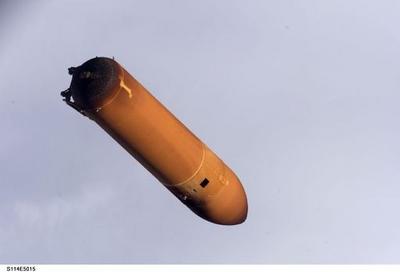 handheld still images taken by Discovery's crew of the external fuel tank as it was jettisoned after launch on July 26. Initial analysis of the imagery shows a large piece of foam that separated from the tank during the Shuttle's ascent to orbit. The foam detached from an area of the tank called the Protuberance Air Load (PAL) Ramp. This debris also was identified during ascent from a live video camera mounted on the external tank. The television view indicated the debris did not impact Discovery. In this still image, the area of missing foam on the tank is indicated by a light spot near the upper edge of the tank just below the liquid oxygen feedline. (Image Credit: NASA)
handheld still images taken by Discovery's crew of the external fuel tank as it was jettisoned after launch on July 26. Initial analysis of the imagery shows a large piece of foam that separated from the tank during the Shuttle's ascent to orbit. The foam detached from an area of the tank called the Protuberance Air Load (PAL) Ramp. This debris also was identified during ascent from a live video camera mounted on the external tank. The television view indicated the debris did not impact Discovery. In this still image, the area of missing foam on the tank is indicated by a light spot near the upper edge of the tank just below the liquid oxygen feedline. (Image Credit: NASA) 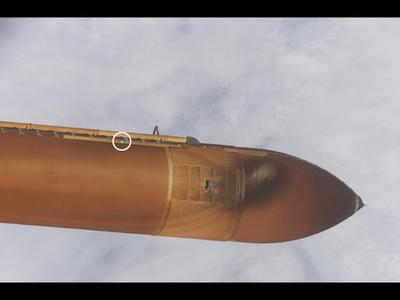
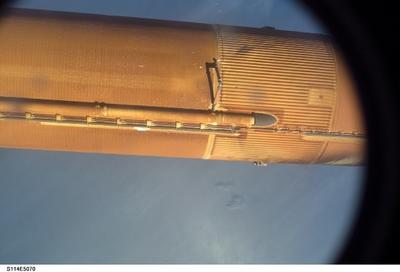
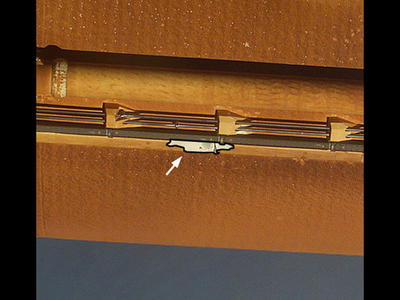
And that's not all: the Shuttle itself shed heat-ablative tiles:
A 1 1/2-inch-wide bit of tile captured on camera appeared to fly off the shuttle's belly, on the edge of a door that encloses the nose landing gear. It was not clear if the tile had been struck by anything. Pieces of tile, which protect the shuttle from searing heat on return to Earth, have been lost on past flights without preventing a safe homecoming.I agree with Rand Simberg that NASA will attempt a normal re-entry. I pray they succeed.
But once the crew is safe, scrap the Shuttle:
- America's space program is directionless. The program is justified as proving NASA can run a shuttle; both the shuttle and everything else is supposed to support an international space station we don't need, tied to international partners who constantly shave their own commitments. Bootstrapping can't justify NASA's taxpayer-funded budget.
- The Shuttle's a failure. Intended to open a new era of everyday space transportation, the spacecraft must be rebuilt -- largely by hand -- after each mission, a process that takes months. And, as Challenger and Columbia proved, the risks are anything but routine.
- NASA's too bureaucratic to change. Created as a political vehicle to funnel government contracts to the districts of the powerful -- especially Texan Lyndon Johnson -- NASA's immune to the romance and opportunities of space travel--and too mature to change.
Terminate all NASA's current missions, and redirect their efforts to an unmanned-Mars lander. That lander would carry a tiny payload--an unconditional note issued by the United States promising to pay the bearer $20 billion. Upon the successful Mars touchdown, NASA would publish a detailed map of the landing site--and then close. No more federal budget, no more agency. Just a potential future liability.More:
It worked for longitude--why not similarly jump-start the technological innovation necessary to get to Mars?
MaxedOutMama's uncertain; RightwingNutHouse has an excellent essay on why NASA is antiquated.
(via NIF)
Still More:
More photos, via Fox News:
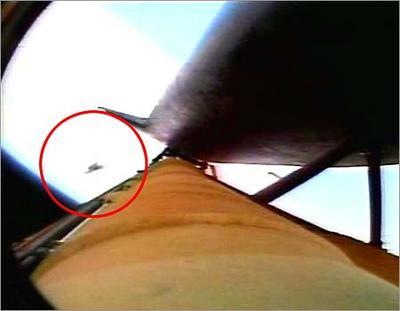 What appears to be a sizable piece of material is seen coming off the space shuttle Discovery's external fuel tank after liftoff. (Source: Fox)
What appears to be a sizable piece of material is seen coming off the space shuttle Discovery's external fuel tank after liftoff. (Source: Fox)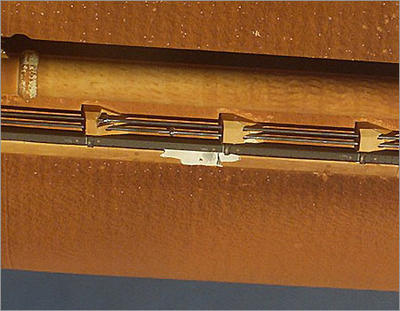 The area of missing foam on Discovery's external fuel tank [without post processing outlining] is indicated by a light spot, center, just below the liquid oxygen feedline. (Source: Fox)
The area of missing foam on Discovery's external fuel tank [without post processing outlining] is indicated by a light spot, center, just below the liquid oxygen feedline. (Source: Fox)More & More:
Cold Spring Shops: "Innovation, safety, have fun doing it. They probably aren't having much fun in Houston, Huntsville, and the Cape these days."
4 comments:
Hey, Carl, look at this:
http://www.space.com/news/050727_branson_rutan.html
Gold Rush, the Sequel
There may be merit in your idea, but even an unconditional promissory note might not do the trick for some. Why not send gold bars? Or at least put them into an escrow account here on earth. Then we could call it another Gold Rush, to keep with the Final Frontier theme.
Let's just hope we don't lose as many gold diggers or private shuttles enroute or on site. Burial sites and trash dumps were cheap in the prairies and Rockies. Floating debris in space could cause some problems for the next group to go up, our satellites, and those within hitting distance on earth.
And I am not sure $20 billion is enough. That might only cover the costs for the indemnification and liability insurance in this day and age.
Up the amount a tad, and there may be a few more rocket scientists and others who decide to enter the aerospace industry. Others might decide as a result to enter fields related to finance or . . . the law.
Intersting result of certain insular consequences. According to Blogger Mike's Noise ...here is what no one seems to be talking about - the problems with foam peeling and breaking off the main fuel tank are relatively new. In 1997, NASA bent to pressure from environmental groups and began using a new type of foam on the main fuel tank.
Why all the fuss? Because the traditional foam insulation, the product that had been specified in the 1970 Shuttle designs, the product that was used up until 1997, was made by injecting polymer with chlorofluorocarbons -- "freon" -- compounds whose use was severely limited under the 1991 Montreal Protocol. With the adoption of this protocol by the U. S., the Environmental Protection Agency set target dates for major industries to phase out the use of freon.
After the new foam was used on Columbia mission STS-87 in November 1997, post-flight examination of the craft found that 308 of the special heat-absorbent ceramic tiles that cover the Shuttle's outer skin were damaged. The average number of damaged tiles for previous missions was 40. NASA engineers immediately suspected that the new insulating foam was breaking loose, but NASA supervisors were apparently more interested in impressive, successfully-completed missions than in adequate mission safety. The peeling foam was written off as a negligible risk. (My emphasis)
And if DDT were not banned by the UN, the number of yearly malaria deaths among children in Africa would drop considerably.
You're right on DDT; depressed to hear it might extend to foam. Hope no more lives are sacrificed.
Post a Comment